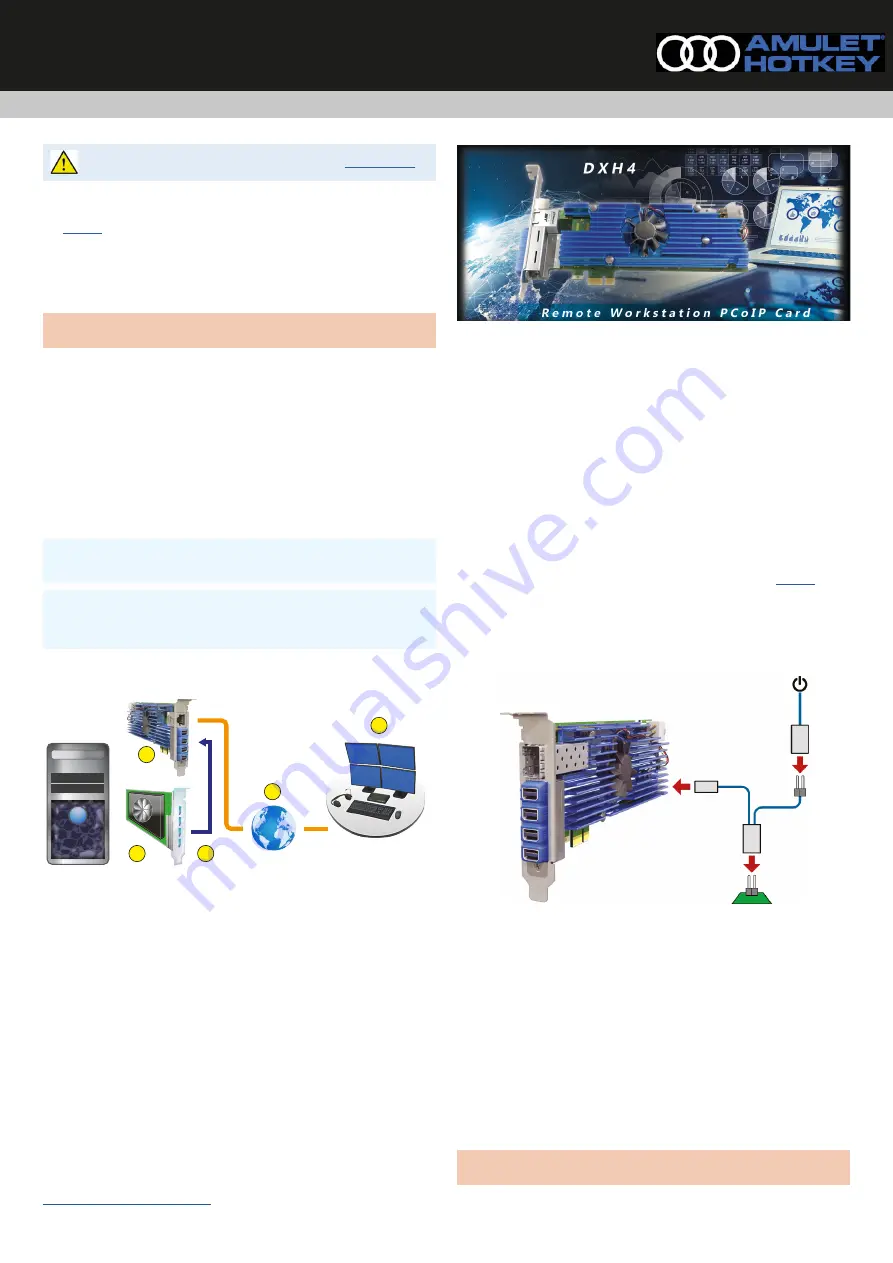
DXH4
PCoIP Host Card for PCs and Workstations
Quick Start Guide
QS-DXH4-0001 v2.0 March 2020
For Health and safety information, refer to the sheet
.
The DXH4 is a quad video head PCoIP® host card that installs into a PCIe slot on
a computer and connects to an Amulet Hotkey zero client over an IP network.
See
. One DXH4 card can support four 1920 x 1200 displays or two high
resolution 2560 x 1600 displays. Cables take digital video output from the host
graphics card(s) to four Mini DisplayPorts on the DXH4.
The standard DXH4 has an RJ45 network port. The DXH4-M has a network port
designed to accept a copper or fiber SFP module (available separately).
Note:
This guide uses ‘DXH4’ as a generic term when referring to both the
standard DXH4 product and the DXH4-M product.
Requirements
The DXH4 kit includes:
DXH4 host card with a full-height or low profile I/O bracket fitted;
Other size of I/O bracket;
4 x 400mm video cables, DisplayPort to MiniDP;
Remote Power Control (RPC) cable assembly.
Graphics cards in the host computer must have digital video output. The DXH4
and DXH4-M can only accept video from a digital source.
Caution:
!
Only install and operate the DXH4 within an enclosed environment
such as inside a PC or workstation.
Caution:
!
The DXH4 is not a ‘hot-plug’ device. Before you install or remove
a DXH4 from the PCIe slot, disconnect all power from the host computer for at
least 60 seconds. This allows the PC power rails to fully discharge.
Example deployment in a PCoIP system
Figure 1:
Quad video zero client
DXH4
Workstation
2
1
3
4
5
DisplayPort outputs on the system graphics card(s) (
1
) connect
directly to up to four MiniDisplayPort inputs on the DXH4 (
2
) with the cables
supplied (
3
). The DXH4 connects over a LAN/WAN (
4
) to a remote client (
5
).
Before you start
1
Record the MAC address on the serial number label. You may need the MAC
address when pairing the DXH4 to a zero client.
If your network uses DHCP, the DXH4 obtains its IP address from the DHCP
server. If no DHCP server is available, the DXH4 times out after three minutes
and adopts the default IP address 192.168.1.100.
2
Confirm that the correct I/O bracket is fitted to the DXH4 card. A spare full-
height or low-profile bracket are supplied with the DXH4.
See the DXH4 user manual for how to remove and replace the I/O bracket.
3
Ensure that the host computer is turned off.
4
Unplug the power cable.
Install the DXH4 or DXH4-M
Always use appropriate anti-static handling procedures when handling the PCoIP
host card or an opened computer.
1
Remove the chassis cover and locate an available PCIe slot.
2 Insert the DXH4 host card into the PCIe slot.
3
Secure the I/O bracket in place.
4 (DXH4-M only) Fit an SFP module into the DXH4-M network socket.
Connect a Remote Power Cable (RPC) (optional)
Some workstations may require a RPC to implement remote power-cycling.
Contact technical support to check your cable requirements. See
.
1
Disconnect the existing power cable between the power button (4) and the
motherboard (3).
2
Connect the RPC cable (1) between the RPC socket on the DXH4 (2) and the
motherboard (3) and the PC power button (4).
Figure 2:
2
1
3
4
1.
RPC assembly.
2.
RPC socket on the DXH4-M
3.
Motherboard
power switch header on the host PC
4.
Front panel power switch on the host
Complete the installation
1
Connect a suitable network cable between the DXH4 and the PCoIP network.
For the best performance, use a network dedicated to PCoIP traffic.
2 Connect the video outputs on the host computer graphics card(s) to the Mini
DisplayPort video inputs on the DXH4.
3
Replace the chassis cover and reconnect the power cable.
4 Restart the host computer.
The operating system detects the DXH4 and locates the appropriate drivers.
Note:
See the DXH4 user manual to install dual DXH4s for an octal video
configuration, or to install a network extender card.




















